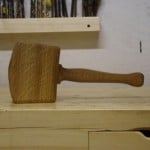Is this saw tooth pattern intentional?
Welcome! / Forums / General Woodworking Discussions / Tools and Tool Maintenance/Restoration / Is this saw tooth pattern intentional?
Tagged: saw sharpening
- This topic has 15 replies, 9 voices, and was last updated 9 years, 1 month ago by
Joel Finkel.
-
AuthorPosts
-
Hi,
(Thank you all for all your input on leather strop and gouge sharpening!)
I purchased a vintage saw with a funny tooth pattern. Please see the attached photo. At first I thought it was a bad sharpening job, but I noticed a regular pattern: a large tooth followed by a small tooth. I’m wondering if this pattern is intentionally done. If so, I’d like to know more about it, and what to do to sharpen the saw in that pattern. (Also, should I preserve the pattern?)
[attachment file=”saw_teeth.JPG”]
The saw is a vintage E.C. Atkins panel saw. 11 ppi or tpi, I’m not sure which. Saw plate has “11” inscribed. I wanted to sharpen it in rip-cut pattern, and use it as a cross-cut saw.
Thank you.
Attachments:
You must be logged in to view attached files. 20 March 2015 at 3:51 am #125719
20 March 2015 at 3:51 am #125719Michi, I’m not an expert on saw tooth patterns, but my guess is that this was someone’s idea to try something different – maybe the manufacturer or maybe the previous owner. If every other tooth is set like on a saw with all the same size teeth, then all the small teeth would be set to one side and all the large teeth the other side. Maybe the owner had an issue with saw drift and was trying to fix that by making the teeth smaller on one side.
Personally, I don’t see any need for the different size teeth. I would correct it by filing them all the same.
But you say you are going to file it rip to use as a cross cut? Why? I know sometimes Paul uses a rip pattern to cut cross cut (to save time getting the other saw), but he also has cross cut pattern saws.
20 March 2015 at 4:31 am #125721Looks like the teeth on the left have fleam, but maybe have not been jointed in a long time?
I think you’ll find that a rip saw will not work well for cross cutting. It will blow out the far side. A cross cut can rip, but a rip can’t cross cut.
When you chop a tree, you are cross cutting. The axe is on its side and angled down, then up, then down, etc. That’s all a cross cut pattern is. A rip pattern would be like holding the axe vertically and cutting a dado all the way through. It would fracture the wood, not cut it.

Looks to me like the previous owner tried to sharpen it and didn’t do a great job. The term I have seen is “Cows & Calves”, where one tooth is smaller than the other and the pattern is repeated.
It is also set up crosscut already, so just keep it that way and reshape the big teeth down until they all match up. Or just file them all in a rip pattern and go from there.
 20 March 2015 at 11:46 am #125725
20 March 2015 at 11:46 am #125725It looks like teeth filed like that on timber saws, so perhaps the saw was used by a previous owner for cutting up logs.
The tooth pattern looks like an “M” or “Great American” pattern.
http://www.canbike.org/off-topic/reference/crosscut-saw-tooth-reference-guide.html
EDIT: Or they just sucked at saw tooth filing. Ha!
20 March 2015 at 2:28 pm #125736I agree poor sharpeneing job and ended up with cows and calves from what I see.
Steve
Thank you all.
I got the idea for filing the saw in rip-cut pattern and using it for crosscut from one of Paul’s videos:
I don’t know yet how to file a saw in cross-cut pattern. (If there’s any good instruction somewhere for this, please let me know.) I purchased an 11 ppi/tpi saw, thinking that the teeth are small enough that it will work well enough for crosscutting with rip-cut teeth.
Can one easily switch the filing pattern on a saw? If I were to file the saw in rip-cut pattern today, then can I file the saw in cross-cut pattern the next time? And switch it back again to rip cut sometime later? May be I can start using the saw with rip-cut pattern and switch it later to cross-cut? When I learn how to do it, that is.
 20 March 2015 at 4:44 pm #125748
20 March 2015 at 4:44 pm #125748Misha, this link gets to a very complete 2 hour video on saw sharpening. The video is long, but the author does a great job at explaining every detail. I think he gets to sharpening a crosscut saw later in the video. https://www.youtube.com/watch?v=u-_MF2Mnxwc
I don’t think your idea of filing rip, then cross, then rip etc. is a good idea. You really want to have a saw dedicated to the type of cutting you need to do. Try to find another saw that you can dedicate. You can often find old saws at garage sales or flea markets that are begging to be brought back to life.

You can use a rip saw for cross cutting, it’s not perfect but it works. Just make sure to have knife walls on both sides of the saw cut. If you are just going to use it as a cross cut saw and never rip with it then it would be better to file it for cross cut only.
All saws that you find in the big box stores are cross cut and works well for this so if you want a cheep dedicated cross cut saw you can go that route.
 20 March 2015 at 9:11 pm #125761
20 March 2015 at 9:11 pm #125761Matt’s video link is good, and I’d recommend this website:
http://www.vintagesaws.com/cgi-bin/frameset.cgi?left=main&right=/library/library.html
I would highly recommend you file the saw rip, and leave it at that. Don’t file it one way then another. Learn to file and sharpen the saw rip, then learning how to do it crosscut later is much easier. You can crosscut just fine with an 11 ppi rip saw, just make your knife walls and understand you’ll have to do some cleaning-up planing afterwards.
Use Paul’s progressive pitch technique, too.
 21 March 2015 at 12:09 pm #125790
21 March 2015 at 12:09 pm #125790Looks like classic poor sharpening to me.
Go rip, three reasons: crosscut sharpening is a much trickier beast than rip; crosscut saws can be had new from anywhere for a few quid, not so rip; a small-toothed rip-filed saw is probably more versatile than a similar crosscut.
Good luck,
Matt
23 March 2015 at 12:39 pm #125843For me it looks like the owner has tried to make a 5tpi saw from a 10tpi saw piece by piece.
Therefore you have to skip one teeth at filing.
Doing this the smaller teeth will more and more melt into the bigger tooth. In the end
they will be gone and you have a 5tpi saw.
Just another idea…23 March 2015 at 4:34 pm #125845Thomas Lie-Nielson has a short series on sharpening backsaws. Search for them on YouTube. My favorite is the one by Ron Herman. You have to pay for it, but I think it’s well worth the money. He uses very simple wood jigs, attached to the end of the file, to help judge the proper rake and fleam angles. You can make one in 5 minutes or buy a fancy one from Lee Valley for about $50.
 23 March 2015 at 5:41 pm #125846
23 March 2015 at 5:41 pm #125846I second the wood jigs mentioned by Joel. They’re very useful. My saw filing much improved when I started using them.
Hi,
I do have a $6 saw that I sharpened for rip-cut (my first-ever sharpening victim), so I can dedicate this saw for cross-cutting. I finally watched the Andy Lovelock video, and I feel I’m ready to put some fleams into my saw! I think “cows and calves” is spot on. That must be what I have. I will make the wooden jig. Thank you all.
I’m also looking for a fine-toothed tenon saw, say 14 ppi. I’m thinking rip-cut pattern for that one and use it for both rip-cutting and cross-cutting. I’d hate to have to buy two tenon saws, at least for now.
-
AuthorPosts
- You must be logged in to reply to this topic.
